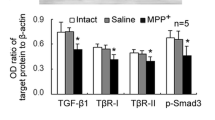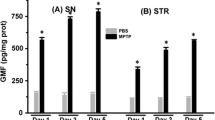Abstract
The degeneration of midbrain dopaminergic (mDA) neurons is the hallmark of Parkinson’s disease (PD), and several in vivo and in vitro models have been established to resemble the processes occurring during disease progression. One of the most commonly used disease models for PD is the toxin 1-methyl-4-phenyl-1,2,3,6-tetrahydropyridine (MPTP), which selectively kills mDA neurons when applied systemically. In vivo, MPTP intoxication is accompanied by a strong microglia response which is characterised by the release of inflammatory molecules such as tumour necrosis factor alpha (TNF-alpha) and interleukin-6 (IL6) that are believed to further drive inflammation-mediated degeneration of mDA neurons. Here, we addressed the question whether primary ventral mDA neurons and MN9D cells release cytokines in vitro and how these cytokine profiles change after treatment with MPP+. Our results demonstrate that both culture models show different cytokine profiles under control conditions indicating that comparisons between both models should be made very carefully. Moreover, MN9D cells released high levels of IL6 and IP10/CXCL10, both of which were down regulated after treatment with MPP+. MN9D-derived IL6 seems to be important for MN9D survival since neutralisation of endogenous IL6 resulted in degeneration of MN9D cells. Moreover, recombinant IL6 was able to rescue MN9D cells and primary mDA neuron cultures from MPP+-induced neurotoxicity, underlining the neuroprotective properties of IL6.






Similar content being viewed by others

References
Adams, J. C. (1981). Heavy metal intensification of DAB-based HRP reaction product. Journal of Histochemistry and Cytochemistry, 29(6), 775.
Akaneya, Y., Takahashi, M., & Hatanaka, H. (1995). Interleukin-1 beta enhances survival and interleukin-6 protects against MPP+ neurotoxicity in cultures of fetal rat dopaminergic neurons. Experimental Neurology, 136(1), 44–52.
Balasingam, V., Tejada-Berges, T., Wright, E., Bouckova, R., & Yong, V. W. (1994). Reactive astrogliosis in the neonatal mouse brain and its modulation by cytokines. Journal of Neuroscience, 14(2), 846–856.
Bauer, S., Kerr, B. J., & Patterson, P. H. (2007). The neuropoietic cytokine family in development, plasticity, disease and injury. Nature Reviews Neuroscience, 8(3), 221–232.
Block, M. L., Zecca, L., & Hong, J. S. (2007). Microglia-mediated neurotoxicity: Uncovering the molecular mechanisms. Nature Reviews Neuroscience, 8(1), 57–69.
Bolin, L. M., Strycharska-Orczyk, I., Murray, R., Langston, J. W., & Di Monte, D. (2002). Increased vulnerability of dopaminergic neurons in MPTP-lesioned interleukin-6 deficient mice. Journal of Neurochemistry, 83(1), 167–175.
Brodacki, B., Staszewski, J., Toczyłowska, B., Kozłowska, E., Drela, N., Chalimoniuk, M., et al. (2008). Serum interleukin (IL-2, IL-10, IL-6, IL-4), TNFalpha, and INFgamma concentrations are elevated in patients with atypical and idiopathic parkinsonism. Neuroscience Letters, 441(2), 158–162.
Campbell, I. L., Abraham, C. R., Masliah, E., Kemper, P., Inglis, J. D., Oldstone, M. B., et al. (1993). Neurologic disease induced in transgenic mice by cerebral overexpression of interleukin 6. Proceedings of the National Academy of Sciences of the United States of America, 90(21), 10061–10065.
Cardenas, H., & Bolin, L. M. (2003). Compromised reactive microgliosis in MPTP-lesioned IL-6 KO mice. Brain Research, 985(1), 89–97.
de Jong, E. K., Dijkstra, I. M., Hensens, M., Brouwer, N., van Amerongen, M., Liems, R. S., et al. (2005). Vesicle-mediated transport and release of CCL21 in endangered neurons: A possible explanation for microglia activation remote from a primary lesion. Journal of Neuroscience, 25(33), 7548–7557.
Gadient, R. A., & Otten, U. (1993). Differential expression of interleukin-6 (IL-6) and interleukin-6 receptor (IL-6R) mRNAs in rat hypothalamus. Neuroscience Letters, 153(1), 13–16.
Gadient, R. A., & Otten, U. (1994). Expression of interleukin-6 (IL-6) and interleukin-6 receptor (IL-6R) mRNAs in rat brain during postnatal development. Brain Research, 637(1–2), 10–14.
Hama, T., Kushima, Y., Miyamoto, M., Kubota, M., Takei, N., & Hatanaka, H. (1991). Interleukin-6 improves the survival of mesencephalic catecholaminergic and septal cholinergic neurons from postnatal, two-week-old rats in cultures. Neuroscience, 40(2), 445–452.
Itano, Y., & Nomura, Y. (1995). 1-Methyl-4-phenyl-pyridinium ion (MPP+) causes DNA fragmentation and increases the Bcl-2 expression in human neuroblastoma, SH-SY5Y cells, through different mechanisms. Brain Research, 704(2), 240–245.
Jellinger, K. A. (2001). The pathology of Parkinson’s disease. Advances in Neurology, 86, 55–72.
Krieglstein, K., Suter-Crazzolara, C., Fischer, W. H., & Unsicker, K. (1995). TGF-beta superfamily members promote survival of midbrain dopaminergic neurons and protect them against MPP+ toxicity. EMBO Journal, 14(4), 736–742.
Kunioku, H., Inoue, K., & Tomida, M. (2001). Interleukin-6 protects rat PC12 cells from serum deprivation or chemotherapeutic agents through the phosphatidylinositol 3-kinase and STAT3 pathways. Neuroscience Letters, 309(1), 13–16.
Li, X. Z., Bai, L. M., Yang, Y. P., Luo, W. F., Hu, W. D., Chen, J. P., et al. (2009). Effects of IL-6 secreted from astrocytes on the survival of dopaminergic neurons in lipopolysaccharide-induced inflammation. Neuroscience Research, 65(3), 252–258.
Mandel, S., Grünblatt, E., & Youdim, M. (2000). cDNA microarray to study gene expression of dopaminergic neurodegeneration and neuroprotection in MPTP and 6-hydroxydopamine models: Implications for idiopathic Parkinson’s disease. Journal of Neural Transmission. Supplementum, 60, 117–124.
Milligan, E., Zapata, V., Schoeniger, D., Chacur, M., Green, P., Poole, S., et al. (2005). An initial investigation of spinal mechanisms underlying pain enhancement induced by fractalkine, a neuronally released chemokine. European Journal of Neuroscience, 22(11), 2775–2782.
Mosman, T. (1983). Rapid colorimetric assay for cellular growth and survival: application to proliferation and cytotoxicity assays. Journal of Immunological Methods, 65(1-2), 55-63.
Murakami, M., Hibi, M., Nakagawa, N., Nakagawa, T., Yasukawa, K., Taga, T., et al. (1993). IL-6-induced homodimerization of gp130 and associated activation of a tyrosine kinase. Science, 260(5115), 1808–1810.
Nakajima, A., Yamada, K., Zou, L. B., Yan, Y., Mizuno, M., & Nabeshima, T. (2002). Interleukin-6 protects PC12 cells from 4-hydroxynonenal-induced cytotoxicity by increasing intracellular glutathione levels. Free Radical Biology and Medicine, 32(12), 1324–1332.
Oh, Y. J., Wong, S. C., Moffat, M., & O’Malley, K. L. (1995). Overexpression of Bcl-2 attenuates MPP+, but not 6-ODHA, induced cell death in a dopaminergic neuronal cell line. Neurobiology of Diseases, 2(3), 157–167.
Penkowa, M., Giralt, M., Carrasco, J., Hadberg, H., & Hidalgo, J. (2000). Impaired inflammatory response and increased oxidative stress and neurodegeneration after brain injury in interleukin-6-deficient mice. Glia, 32(3), 271–285.
Przedborski, S., Jackson-Lewis, V., Naini, A. B., Jakowec, M., Petzinger, G., Miller, R., et al. (2001). The parkinsonian toxin 1-methyl-4-phenyl-1,2,3,6-tetrahydropyridine (MPTP): A technical review of its utility and safety. Journal of Neurochemistry, 76(5), 1265–1274.
Sawada, H., Ibi, M., Kihara, T., Urushitani, M., Nakanishi, M., Akaike, A., et al. (2000). Neuroprotective mechanism of glial cell line-derived neurotrophic factor in mesencephalic neurons. Journal of Neurochemistry, 74(3), 1175–1184.
Scalzo, P., Kümmer, A., Cardoso, F., & Teixeira, A. L. (2010). Serum levels of interleukin-6 are elevated in patients with Parkinson’s disease and correlate with physical performance. Neuroscience Letters, 468(1), 56–58.
Schöbitz, B., de Kloet, E. R., Sutanto, W., & Holsboer, F. (1993). Cellular localization of interleukin 6 mRNA and interleukin 6 receptor mRNA in rat brain. European Journal of Neuroscience, 5(11), 1426–1435.
Shimma, N., Akiyama, N., Umezawa, M., Okuma, Y., Nomura, Y., Saito, T., et al. (2003). Possible role of interleukin-6 in PC12 cell death induced by MPP+ and tetrahydroisoquinoline. Journal of Pharmacological Sciences, 93(4), 471–477.
Taga, T. (1996). Gp130, a shared signal transducing receptor component for hematopoietic and neuropoietic cytokines. Journal of Neurochemistry, 67(1), 1–10.
van Steenwinckel, J., Reaux-Le Goazigo, A., Pommier, B., Mauborgne, A., Dansereau, M. A., Kitabgi, P., et al. (2011). CCL2 released from neuronal synaptic vesicles in the spinal cord is a major mediator of local inflammation and pain after peripheral nerve injury. Journal of Neuroscience, 31(15), 5865–5875.
Vinet, J., de Jong, E. K., Boddeke, H. W., Stanulovic, V., Brouwer, N., Granic, I., et al. (2010). Expression of CXCL10 in cultured cortical neurons. Journal of Neurochemistry, 112(3), 703–714.
Wang, L., Yi, T., Kortylewski, M., Pardoll, D. M., Zeng, D., & Yu, H. (2009). IL-17 can promote tumor growth through an IL-6-Stat3 signaling pathway. The Journal of Experimental Medicine, 206(7), 1457–1464.
Wruck, C. J., Streetz, K., Pavic, G., Götz, M. E., Tohidnezhad, M., Brandenburg, L. O., et al. (2011). Nrf2 induces interleukin-6 (IL-6) expression via an antioxidant response element within the IL-6 promoter. Journal of Biological Chemistry, 286(6), 4493–4499.
Acknowledgments
The authors thank Susanna Glaser for her excellent technical support.
Conflict of interest
The authors declare that they have no conflict of interests.
Author information
Authors and Affiliations
Corresponding author
Rights and permissions
About this article
Cite this article
Spittau, B., Zhou, X., Ming, M. et al. IL6 Protects MN9D Cells and Midbrain Dopaminergic Neurons from MPP+-Induced Neurodegeneration. Neuromol Med 14, 317–327 (2012). https://doi.org/10.1007/s12017-012-8189-7
Received:
Accepted:
Published:
Issue Date:
DOI: https://doi.org/10.1007/s12017-012-8189-7



